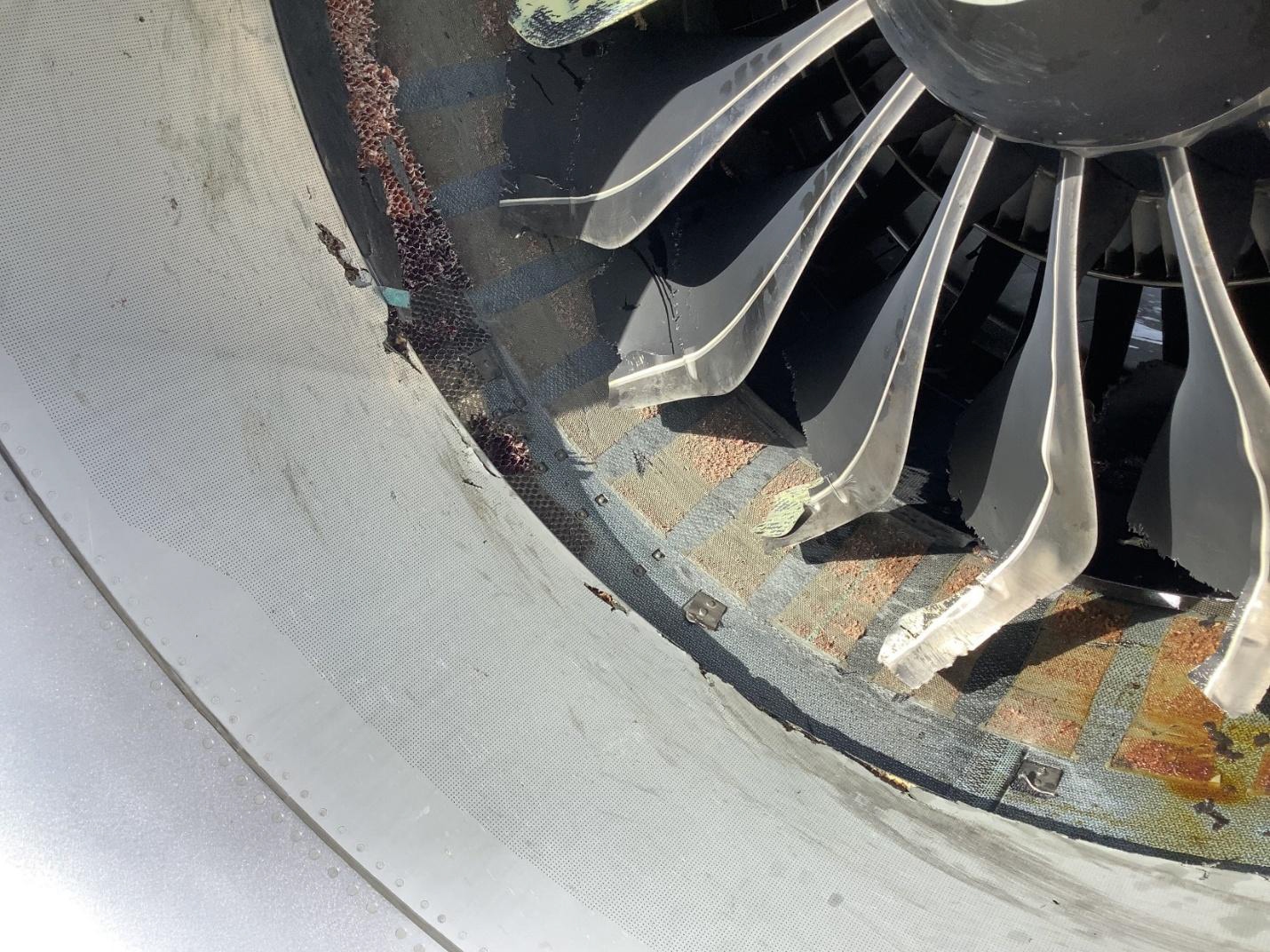
Close-up photo of damage to the left engine. (Source: Southwest Airlines)
What Happened
We are providing the following information to urge the Federal Aviation Administration (FAA), the European Union Aviation Safety Agency (EASA), the Civil Aviation Administration of China (CAAC), CFM International, and Boeing to take action on safety recommendations in this report. These recommendations address the potential for smoke to enter the cockpit or cabin after activation of the load reduction device (LRD) resulting from an engine blade failure or imbalance on CFM LEAP-1B engines and pilot awareness about what to do if this occurs.[1] We identified this issue during our ongoing investigation of an incident involving Southwest Airlines flight 554, a Boeing 737-8, in which smoke filled the cockpit after a bird was ingested into the left (No. 1) engine, a CFM LEAP-1B. The NTSB is issuing an urgent safety recommendation to the FAA. In addition, we are issuing two safety recommendations to the FAA and EASA and one safety recommendation each to Boeing, CFM International, and the CAAC.
- CFM International is a joint venture between GE Aerospace and Safran Aircraft Engines. The LEAP-1B engine received joint type certification from the FAA and EASA in 2016.
What We Found
- Even though pilot action can mitigate the amount of smoke released into the cockpit or cabin after load reduction device activation on CFM International LEAP-1B engines, CFM International and Boeing’s planned software modification, once incorporated, would likely close the pressure regulating shutoff valve more quickly, thus minimizing the quantity of smoke and reducing the flight crew’s workload.
- It is critical to ensure that pilots who fly airplanes equipped with CFM International LEAP-1B engines are fully aware of the potential for smoke in the cockpit if the load reduction device is activated during a critical phase of flight (takeoff or landing).
- Potential unintended effects of load reduction device activation on other CFM International LEAP engine models require comprehensive evaluation and, if needed, remediation.
What We Recommend
As a result of this investigation, the we made the following new safety recommendations.
To the Federal Aviation Administration:
Ensure operators inform flight crews of airplanes equipped with CFM International LEAP-1B engines of the circumstances described in National Transportation Safety Board Aviation Investigation Report AIR-25-03, emphasizing Boeing’s changes to the quick reference handbook and flight crew operations manual so pilots are aware of actions to take if they encounter smoke in the cockpit or cabin after load reduction device activation. (A-25-10) Urgent
To the Federal Aviation Administration and the European Union Aviation Safety Agency:
Once CFM International and Boeing complete the development and certification process for software modifications to the CFM International LEAP-1B engines, require all operators of airplanes equipped with CFM International LEAP-1B engines to incorporate the software modification developed in response to Safety Recommendations A-25-13 and A-25-14 to prevent or limit the amount of smoke released into the cockpit or cabin after load reduction device activation. (A-25-11)
To the Federal Aviation Administration, the European Union Aviation Safety Agency, and the Civil Aviation Administration of China:
Work with CFM International, Airbus, and the Commercial Aircraft Corporation of China to determine if CFM International LEAP-1A or -1C engines are at risk of smoke in the cockpit or cabin as a result of load reduction device activation and require affected operators to incorporate any modification that results. (A-25-12)
To Boeing:
Work with CFM International to complete the development and certification process for a software modification for CFM International LEAP-1B engines that will prevent or limit the amount of smoke released into the cockpit or cabin after load reduction device activation. (A-25-13)
To CFM International:
Work with Boeing to complete the development and certification process for a software modification for CFM International LEAP-1B engines that will prevent or limit the amount of smoke released into the cockpit or cabin after load reduction device activation. (A-25-14)
.png)




